Chicora Walk
Chicora Walking Tour
Walking the streets of Charleston, one of the oldest cities in America, is walking through an important part of the tapestry of American history. Established in 1670, Charleston grew to become one of the nation’s leading ports and was an especially important for trade and military defense in the South. In fact, by 1750 Charleston was the largest and wealthiest city south of Philadelphia.
On our walk together, you’ll become part of a city with a rich and fascinating story to tell. From it’s wealth and opulence to the many disasters that fell upon it and its participation in the darkest parts of American history and humanity. Like any city with opportunity, people of great diversity came from near and far to participate in the building of one of the early melting pots in America. They built enduring structures; houses, churches, businesses and forts all with their own stories to tell. These streets and structures have been walked by presidents and foreign dignitaries, generals and soldiers, slaves and slave traders, and pirates and merchants. You will feel a part of the celebrations held for visiting presidents to the devastating fires, earth quake, hurricanes along with attacks by foreign invaders, pirates and eventually Union armies that were defended against.
Let's Take a Walk
“Chicora” are the fresh coastal breezes that add to Charleston’s charm and natural beauty. Legend has it that during a particularly deadly outbreak of disease the natives suggested that their foreign neighbors move down to the peninsula where the healing, “chicora” breezes would restore their health. It may be that these breezes also limited the population of mosquitos that were vectoring their ailments and so the settlers indeed found improved health. They probably found other things such as fertile soil and other resources that made it an ideal place to build give rise to Charleston, South Carolina.
Tour of the Tour
St. Philip’s Episcopal Church
- Oldest congregation in Charleston
- John C. Calhoun, 2 time VP buried here
- Christopher Gadsen, William Rhett, Charles Pinckney and Edward Rutledge buried here
- Four degree tilt due to earthquake of 1886

Dock Street Theater
- First building in America to be used for theatrical performances
- Destroyed in Great Fire of 1740
- Reopened as Planter’s Hotel in 1809
- Planter’s punch invented here
- Reopened in 1937 as a theater
- Reopened in 2010 as a theater
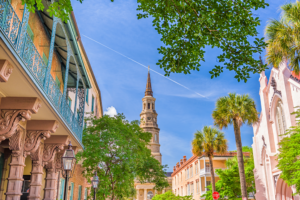
French Huguenot Church
- Also known as the Church of the Tides
Chalmers Street
- One of 8 remaining cobblestone streets in Charleston
The Pink House
- 2nd oldest house in Charleston
Ryan’s Mart
- 40 to 50 slave markets
- This is the only one that is still standing
- Currently a museum
- 40% of all slaves brought to this country came in through the port of Charleston
- Here we discuss this part of our city’s history
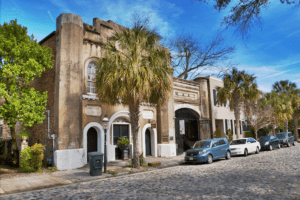
8 ½ State Street
- Discuss different architectural features and why Charleston is one of the most well-preserved cities in America
Old Exchange
- Built in 1771
- It is the last building built with British money
- This was a gift from the British
- August 1776, the Declaration of Independence was read to the citizens of Charleston from these steps
- In 1788, the Constitution was ratified by South Carolina in this building
- In 1791, President Washington visited and a three-day ball was held for him where he danced with over 250 women
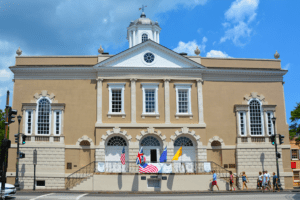
Rainbow Row
- Originally merchants’ homes
- Shops were on the first floor and the merchant’s families lived on the second and third floors
- Was rehabbed in the 1930’s
- Painted these colors to celebrate our connection with Barbados
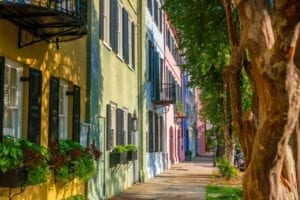
Robert Smalls
- Born into slavery
- Was sent to Charleston and became a wheelman in the harbor
- Assigned to the CSS Planter
- Stole the ship and turned it over to the Union
- He became a Captain in the Union Army
- Returned to Beaufort after the War and bought the plantation that he was born on
- Served one term in the South Carolina General Assembly and five terms in the US House of Representatives
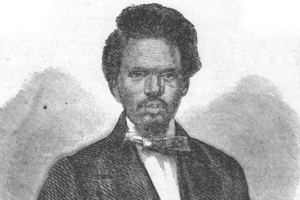
Stoll’s Alley
- We will see several great examples of ironwork made by Philip Simmons
- Philip Simmons was one of the most well-known blacksmiths in America















